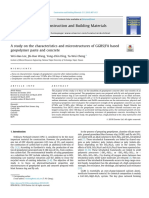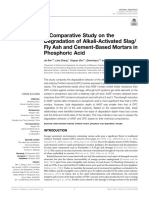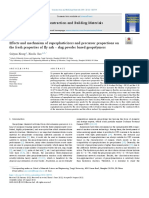Mechanical Properties of Fly-Ash-Based Geopolymer Concrete: Aci Materials Journal Technical Paper
Mechanical Properties of Fly-Ash-Based Geopolymer Concrete: Aci Materials Journal Technical Paper
Uploaded by
joCopyright:
Available Formats
Mechanical Properties of Fly-Ash-Based Geopolymer Concrete: Aci Materials Journal Technical Paper
Mechanical Properties of Fly-Ash-Based Geopolymer Concrete: Aci Materials Journal Technical Paper
Uploaded by
joOriginal Title
Copyright
Available Formats
Share this document
Did you find this document useful?
Is this content inappropriate?
Copyright:
Available Formats
Mechanical Properties of Fly-Ash-Based Geopolymer Concrete: Aci Materials Journal Technical Paper
Mechanical Properties of Fly-Ash-Based Geopolymer Concrete: Aci Materials Journal Technical Paper
Uploaded by
joCopyright:
Available Formats
ACI MATERIALS JOURNAL TECHNICAL PAPER
Title no. 108-M32
Mechanical Properties of Fly-Ash-Based
Geopolymer Concrete
by E. Ivan Diaz-Loya, Erez N. Allouche, and Saiprasad Vaidya
The mechanical properties of fly-ash-based geopolymer concrete forming calcium silicate hydrates (C-S-H) and calcium
(GPC) were studied. Experimentally measured values of the static aluminates (C-A-S-H). The hydration of these compounds
elastic modulus, Poisson’s ratio, compressive strength, and leads to water deficiency and thus raises the alkalinity of the
flexural strength of GPC specimens made from 25 fly ash (FA) mixture. The increase in alkalinity promotes higher and
stockpiles from different sources were recorded and analyzed. The faster dissolution of silicate and aluminate species from the
results were studied using regression analysis to identify
tendencies and correlations within the mechanical properties of
source material, increasing the rate of poly-condensation/
GPC. It was found that the mechanical behavior of GPC is similar geopolymerization. Thus, the presence of calcium
to that of ordinary portland cement (OPC) concrete, suggesting contributes to the mechanical strength of the resulting
that equations, akin to those given by ACI 318-08, could be hardened matrix not only by forming C-S-H and C-A-S-H
applied for GPC to determine its flexural strength and static but also by enhancing the geopolymerization process.6,8-15
elastic modulus. The validity of an equation to determine the A significant number of researchers have dedicated efforts
density of GPC as a function of FA fineness was also put forward. to study the chemistry behind these binders.2-4,7,8-15 Other
authors have focused on identifying the characteristics
Keywords: alkali-activated cement; fly ash; geopolymer; mechanical inherent to the source material (for example, FA) that impact
characterization. its potential for geopolymerization,6,16,17 whereas still
others have focused on evaluating the environmental impact
INTRODUCTION of recycling FA into geopolymer concrete.18,19 Although
Geopolymers are emerging cementitious binders, synthesized several researchers7,20,21 have studied the mechanical properties
from materials of geological origin (for example, metakaolin) or of geopolymer concrete (GPC), they have focused on analyzing
by-products such as fly ash (FA) that are rich in silica and the effects that mixture proportion, activator solution
alumina. Geopolymer binders result from a chemical reaction concentrations, curing conditions, and so on pose on the
where silica and alumina molecules contained in an active mechanical properties of GPC. To date, limited attention was
pozzolanic material (such as FA) react under highly alkaline given to evaluating tendencies and correlations within the
conditions, typically provided by a sodium (or potassium) mechanical properties of GPC for a wide range of FA sources. It
hydroxide solution and an alkaline silicate (for example, is worth mentioning that efforts are currently being made to
sodium or potassium silicate). Many authors agree that the create an FA database22 from which these correlations can
outcome of this reaction is an amorphous three-dimensional be identified and quantified.
(3-D) network of silicon and aluminum atoms linked by
oxygen atoms in a four-fold coordination similar to the one RESEARCH SIGNIFICANCE
exhibited by zeolites. The positive ion (Na+ or K+) provided One of the main challenges for a widespread use of FA-
by the activator solution serves to balance the negative based GPC is the lack of design equations that represent the
charge generated by having Al3+ atoms in a four-fold correlations and tendencies present in the mechanical
coordination. While the formation mechanism of the properties of GPC. This study is aimed at gaining better
geopolymer network is still debated, it was suggested that understanding of the mechanical behavior of GPC, based on
the reaction can be divided into three main stages: 1) the the effects posed by using different sources of FA. Given that
dissolution of silicate and aluminate species from the source fly ashes that possess optimum characteristics will have
material; 2) transportation and coagulation/gelation; and better geopolymerization potential, thus resulting in better
3) condensation forming a 3-D network of silico- mechanical properties compared to others (assuming similar
aluminates. This reaction mechanism gives geopolymer a mixture design and curing conditions), it is very beneficial to
set of mechanical and chemical properties that are evaluate and compare a statistically meaningful FA database. In
equivalent or even superior to those of ordinary portland addition, this study attempts to develop empirical equations
cement (OPC) concrete.1-6 that capture selected key mechanical attributes.
Many authors refer to geopolymer as inorganic polymer
concrete (IPC), alkaline cements, or alkaline activated FA Materials and methods
(AAFA), especially when using FA as a source of silica and This paper presents the mechanical characterization of
alumina, given that most FA sources typically contain 25 geopolymer concrete batches; each batch was manufactured
impurities such as CaO that are believed to generate other
chemical reactions along with the formation of geopolymer
gel.1,7 Although some details are still debated, many ACI Materials Journal, V. 108, No. 3, May-June 2011.
MS No. M-2010-132.R2 received September 10, 2010, and reviewed under Institute
researchers agree that paralleled to the formation of publication policies. Copyright © 2011, American Concrete Institute. All rights reserved,
geopolymer gel, calcium in the mixture reacts with silicate including the making of copies unless permission is obtained from the copyright proprietors.
Pertinent discussion including authors’ closure, if any, will be published in the March-April
and aluminate monomers dissolved from the source material, 2012 ACI Materials Journal if the discussion is received by December 1, 2011.
300 ACI Materials Journal/May-June 2011
You might also like
- Dux Son 2005Document12 pagesDux Son 2005Patrícia DiasNo ratings yet
- Coagulant-Flocculant Operator Handbook PDFDocument7 pagesCoagulant-Flocculant Operator Handbook PDFGeorge Van BommelNo ratings yet
- Effects of Si-Al Ratio On The Structure and Properties of MetakaolinDocument7 pagesEffects of Si-Al Ratio On The Structure and Properties of MetakaolinHoài BãoNo ratings yet
- Chapter 1 4Document75 pagesChapter 1 4Gurbir Kaur100% (1)
- Alkali Activated Eco-Friendly Metakaolin/Slag Geopolymer Building BricksDocument12 pagesAlkali Activated Eco-Friendly Metakaolin/Slag Geopolymer Building BricksPouya DarvishNo ratings yet
- Tailby, MacKenzie 2010Document8 pagesTailby, MacKenzie 2010SrToshiNo ratings yet
- Fabrication and Engineering Properties of Concretes Based On Geopolymers Alkali-Activated Binders A ReviewDocument64 pagesFabrication and Engineering Properties of Concretes Based On Geopolymers Alkali-Activated Binders A ReviewGuilherme HoffmanNo ratings yet
- E.I. Diaz, E.N. Allouche, S. Eklund: SciencedirectDocument5 pagesE.I. Diaz, E.N. Allouche, S. Eklund: SciencedirectAdji SutamaNo ratings yet
- Structural and Material Performance of Geopolymer Concrete - A Review - ScienceDirectDocument6 pagesStructural and Material Performance of Geopolymer Concrete - A Review - ScienceDirectbamideleraheem1No ratings yet
- STP156620120095 1113241-1Document21 pagesSTP156620120095 1113241-1N SHYAMANANDA SINGHNo ratings yet
- Composites Part B: Violeta Nikoli C, Miroslav Komljenovi C, Nata Sa Dzunuzovic, Tijana Ivanovi C, Zoran Miladinovi CDocument11 pagesComposites Part B: Violeta Nikoli C, Miroslav Komljenovi C, Nata Sa Dzunuzovic, Tijana Ivanovi C, Zoran Miladinovi ChaiyenngocchulaNo ratings yet
- The Coexistence of Geopolymeric Gel and Calcium Silicate Hydrate at The Early Stage of Alkaline ActivationDocument10 pagesThe Coexistence of Geopolymeric Gel and Calcium Silicate Hydrate at The Early Stage of Alkaline ActivationkailashNo ratings yet
- 2004 Brief Review of DevelopmentsDocument10 pages2004 Brief Review of DevelopmentsAvani DedhiaNo ratings yet
- Analysis of Geopolymer Concrete ColumnsDocument10 pagesAnalysis of Geopolymer Concrete ColumnsRodick AndyNo ratings yet
- Whualkalineactivation60years10.4416 JCST2017-00042Document13 pagesWhualkalineactivation60years10.4416 JCST2017-00042sarah.s.souzaNo ratings yet
- Enhancing The Reactivity of Aluminosilicate Materials Toward Geopolymer SynthesisDocument25 pagesEnhancing The Reactivity of Aluminosilicate Materials Toward Geopolymer SynthesiskarskotNo ratings yet
- InfoDocument3 pagesInfoNasser AlmesferNo ratings yet
- Structure Reactivity and Mechanical Properties of PDFDocument13 pagesStructure Reactivity and Mechanical Properties of PDFpmarteeneNo ratings yet
- BalajiA GeopolymerDocument11 pagesBalajiA GeopolymerBalaji AlaguNo ratings yet
- Reactivity, Workability and Strength of Potassium Versus Sodium-Activated High Volume Fly Ash-Based GeopolymersDocument8 pagesReactivity, Workability and Strength of Potassium Versus Sodium-Activated High Volume Fly Ash-Based GeopolymersHilary WatsonNo ratings yet
- Geopolymer Basics PDFDocument30 pagesGeopolymer Basics PDFReshmita PallaNo ratings yet
- HS PDFDocument7 pagesHS PDFYoukhanna ZayiaNo ratings yet
- 2021 Effect of Oxide Composition and Ingredient Proportions On The Rheological and Mechanical PropertiesDocument15 pages2021 Effect of Oxide Composition and Ingredient Proportions On The Rheological and Mechanical PropertiesnurulmienNo ratings yet
- Paper4 - Basalt Fiber AdditionDocument8 pagesPaper4 - Basalt Fiber AdditionApple TimakulNo ratings yet
- ReportDocument22 pagesReportFaisal MohammedNo ratings yet
- A Critical Review On Application of Alkali Activat - 2019 - Case Studies in ConsDocument13 pagesA Critical Review On Application of Alkali Activat - 2019 - Case Studies in Consjahremade jahremadeNo ratings yet
- A State of The Art On Effect of Alkali Activator, Precursor, and Fibers On Properties of Geopolymer CompositesDocument13 pagesA State of The Art On Effect of Alkali Activator, Precursor, and Fibers On Properties of Geopolymer CompositesIqbalNo ratings yet
- Evaluation of Long Term Ageing of Asphalt Mixtures Containing EAF and BOF Steel SlagsDocument21 pagesEvaluation of Long Term Ageing of Asphalt Mixtures Containing EAF and BOF Steel SlagsPamirNo ratings yet
- 1 s2.0 S0950061820313374 MolekuladhesionDocument12 pages1 s2.0 S0950061820313374 MolekuladhesionirawatiNo ratings yet
- Evaluation of Glass Powder-Based Geopolymer Stabilized Road Bases Containing Recycled Waste Glass AggregateDocument11 pagesEvaluation of Glass Powder-Based Geopolymer Stabilized Road Bases Containing Recycled Waste Glass AggregateGeorge Soros100% (2)
- Reactivity and Hydration Behavior in GroDocument6 pagesReactivity and Hydration Behavior in GroAlcides SitoeNo ratings yet
- A Literature Review On Fiber Reinforced Geopolymer ConcreteDocument5 pagesA Literature Review On Fiber Reinforced Geopolymer ConcreteChris BothaNo ratings yet
- Construction and Building Materials: M.A.M. Ariffin, M.A.R. Bhutta, M.W. Hussin, M. Mohd Tahir, Nor AziahDocument7 pagesConstruction and Building Materials: M.A.M. Ariffin, M.A.R. Bhutta, M.W. Hussin, M. Mohd Tahir, Nor AziahAbdullahNo ratings yet
- Corrosion Evaluation of Geopolymer Concrete Made With Fly Ash and Bottom AshDocument16 pagesCorrosion Evaluation of Geopolymer Concrete Made With Fly Ash and Bottom Ashaboodalshouha1998No ratings yet
- Heliyon: Bashar S. Mohammed, Sani Haruna, M.M.A. Wahab, M.S. Liew, Abdulrahman HarunaDocument9 pagesHeliyon: Bashar S. Mohammed, Sani Haruna, M.M.A. Wahab, M.S. Liew, Abdulrahman HarunaHelloNo ratings yet
- Construction and Building Materials: Wei-Hao Lee, Jhi-Hao Wang, Yung-Chin Ding, Ta-Wui ChengDocument7 pagesConstruction and Building Materials: Wei-Hao Lee, Jhi-Hao Wang, Yung-Chin Ding, Ta-Wui ChengMustafaMahdiNo ratings yet
- Optimization of Fly Ash-Slag One-Part Geopolymers With Improved PropertiesDocument25 pagesOptimization of Fly Ash-Slag One-Part Geopolymers With Improved Propertiesbamideleraheem1No ratings yet
- Al Majidi2017 PDFDocument22 pagesAl Majidi2017 PDFRambabu VenkataNo ratings yet
- Understanding The Changes in Engineering Behaviors andDocument16 pagesUnderstanding The Changes in Engineering Behaviors andxrusovalantiNo ratings yet
- Flyash Geopolymer Concrete As Future Concrete: Authors:-Rachit Ghosh, Anil Kumar and Sanjay KumarDocument12 pagesFlyash Geopolymer Concrete As Future Concrete: Authors:-Rachit Ghosh, Anil Kumar and Sanjay KumarWalter Jimmy Flores AlcocerNo ratings yet
- Construction and Building Materials: Guohao Fang, Wing Kei Ho, Wenlin Tu, Mingzhong ZhangDocument12 pagesConstruction and Building Materials: Guohao Fang, Wing Kei Ho, Wenlin Tu, Mingzhong ZhangvikasNo ratings yet
- Synth and Prop of Novel Structural BinderDocument10 pagesSynth and Prop of Novel Structural BinderMaximiliano ZarateNo ratings yet
- 1 s2.0 S2214509522001206 MainDocument16 pages1 s2.0 S2214509522001206 MainMALIKNo ratings yet
- 10 - Chapter 2 PDFDocument21 pages10 - Chapter 2 PDFRAHUL GUNDEBOMMUNo ratings yet
- Tayeh, Basam (Zotero)Document17 pagesTayeh, Basam (Zotero)ROHIT RANJANNo ratings yet
- Fmats 09 845349Document14 pagesFmats 09 845349karthicfinconNo ratings yet
- Construction and Building Materials: Yifeng Ling, Kejin Wang, Xuhao Wang, Sudong HuaDocument14 pagesConstruction and Building Materials: Yifeng Ling, Kejin Wang, Xuhao Wang, Sudong Huaadipurnomo95No ratings yet
- Biocoal Based Fly Ash PaperDocument17 pagesBiocoal Based Fly Ash PaperAhmed SiddiqueNo ratings yet
- Experimental Study On Creep-Recovery Behavior of PPA Modified AspahaltDocument19 pagesExperimental Study On Creep-Recovery Behavior of PPA Modified Aspahaltthillai malarNo ratings yet
- 1 s2.0 S0950061822023911 MainDocument14 pages1 s2.0 S0950061822023911 MainNandia Salsa Restu MulyaniNo ratings yet
- Durability Evaluation of Geopolymer and Conventional Concretes PDFDocument12 pagesDurability Evaluation of Geopolymer and Conventional Concretes PDFJay PatelNo ratings yet
- 2011 01 94 PDFDocument6 pages2011 01 94 PDFVel MuruganNo ratings yet
- Acid Based Geopolymerization Kinetics Effect of Clay Particle Size (Louati-2016)Document8 pagesAcid Based Geopolymerization Kinetics Effect of Clay Particle Size (Louati-2016)juan diazNo ratings yet
- Alkali Activated System As An Alternate To Portland CementDocument11 pagesAlkali Activated System As An Alternate To Portland CementManuelNo ratings yet
- 18.experimental and Finite Element Analysis ofDocument12 pages18.experimental and Finite Element Analysis ofchileanNo ratings yet
- Literature Survey On Geopolymer Concretes and A Research Plan in Indian ContextDocument13 pagesLiterature Survey On Geopolymer Concretes and A Research Plan in Indian ContextVikas Biradar100% (1)
- Materials 15 04599Document12 pagesMaterials 15 04599Jose MolinaNo ratings yet
- An Initial Study On Alkali Activated Limestone BindersDocument12 pagesAn Initial Study On Alkali Activated Limestone BindersRT TorresNo ratings yet
- Alkali-Activated Slag Concrete: Fresh and Hardened BehaviourDocument10 pagesAlkali-Activated Slag Concrete: Fresh and Hardened BehavioursattiricNo ratings yet
- Durability Performance of Geopolymer Concrete Under Sulphate and Acid ExposureDocument6 pagesDurability Performance of Geopolymer Concrete Under Sulphate and Acid ExposureHazen MasrafatNo ratings yet
- Optimizing The Choice of Limestone Deposits For The Production of Portland Cement in CameroonDocument12 pagesOptimizing The Choice of Limestone Deposits For The Production of Portland Cement in CameroonjoNo ratings yet
- Poudeu Et Al 2019Document9 pagesPoudeu Et Al 2019joNo ratings yet
- Performance Characteristics of Lateritic Soil Bricks Fired at Low Temperatures: A Case Study of CameroonDocument11 pagesPerformance Characteristics of Lateritic Soil Bricks Fired at Low Temperatures: A Case Study of CameroonjoNo ratings yet
- Applied Clay Science: Research PaperDocument9 pagesApplied Clay Science: Research PaperjoNo ratings yet
- Mechanical Behaviour of Lateritic Soil Stabilized With Bone Ash and Hydrated Lime For Sustainable Building ApplicationsDocument13 pagesMechanical Behaviour of Lateritic Soil Stabilized With Bone Ash and Hydrated Lime For Sustainable Building ApplicationsjoNo ratings yet
- Case Studies in Construction MaterialsDocument15 pagesCase Studies in Construction MaterialsjoNo ratings yet
- Fracture Properties of Geopolymer Paste and Concrete: GeneralDocument9 pagesFracture Properties of Geopolymer Paste and Concrete: GeneraljoNo ratings yet
- Construction and Building MaterialsDocument7 pagesConstruction and Building MaterialsjoNo ratings yet
- Engineering Properties of Inorganic Polymer Concretes (Ipcs)Document7 pagesEngineering Properties of Inorganic Polymer Concretes (Ipcs)joNo ratings yet
- Engineering Properties of Alkali-Activated y Ash: Aci Materials Journal March 2006Document8 pagesEngineering Properties of Alkali-Activated y Ash: Aci Materials Journal March 2006joNo ratings yet
- Application Story 2 Howmet Turbine Blade GaugingDocument1 pageApplication Story 2 Howmet Turbine Blade GaugingjoaoluNo ratings yet
- What Are ZeolitesDocument26 pagesWhat Are ZeolitesneoobooeNo ratings yet
- Edge Lite - EX - DatasheetDocument1 pageEdge Lite - EX - DatasheetPrashant YadavNo ratings yet
- Underwater PelletiserDocument2 pagesUnderwater PelletiserTuesou MachereNo ratings yet
- 2014 TX Gas Asso Black Powder PaperDocument28 pages2014 TX Gas Asso Black Powder PaperGHOST PAKNo ratings yet
- WJK & WJL SystemDocument1 pageWJK & WJL SystemJOSEPH PARINONo ratings yet
- Astm A827-14Document3 pagesAstm A827-14Артем Титов100% (1)
- 9 - Napilas Integrated School Secondary - Rehabilitation of Ceiling Ivan PudaderaDocument14 pages9 - Napilas Integrated School Secondary - Rehabilitation of Ceiling Ivan PudaderaWerty Gigz DurendezNo ratings yet
- AKINLAJADocument5 pagesAKINLAJAAjilosun Media AgapeNo ratings yet
- Ps8307 LV Motor Starter MaintenanceDocument4 pagesPs8307 LV Motor Starter MaintenancePhuc PhamNo ratings yet
- Plastic Registration As On03032020Document7 pagesPlastic Registration As On03032020ishu vohraNo ratings yet
- Agilent 6850 Gas Chromatograph Maintenance PDFDocument9 pagesAgilent 6850 Gas Chromatograph Maintenance PDFFrancesco MoriscoNo ratings yet
- GDFGDFDocument12 pagesGDFGDFAissa FaikNo ratings yet
- Kode Error Canon MP 258Document5 pagesKode Error Canon MP 258RubiantoNo ratings yet
- 01-SAMSS-022 - Fracture Control Testing Procedures For Line PipeDocument4 pages01-SAMSS-022 - Fracture Control Testing Procedures For Line PipeZahidRafiqueNo ratings yet
- Abbreviations: Commonly Used Abbreviation "A" Abbreviation TableDocument11 pagesAbbreviations: Commonly Used Abbreviation "A" Abbreviation TableJeferson SilvaNo ratings yet
- 220-E EdelstahlfinishDocument16 pages220-E EdelstahlfinishFlavioNo ratings yet
- Modeling of Crankshaft Roller BurnishingDocument2 pagesModeling of Crankshaft Roller BurnishinghajamohamedNo ratings yet
- Classification of InsulatorsDocument1 pageClassification of Insulatorsmjv362No ratings yet
- 2013-6031-2L-0010-Specification For Polyurethane Insulation Coating - Re IDCDocument42 pages2013-6031-2L-0010-Specification For Polyurethane Insulation Coating - Re IDCnguyenquoc1988100% (1)
- Chandra Christianson KapojosDocument22 pagesChandra Christianson KapojossinomicsjournalNo ratings yet
- Lamar 01Document28 pagesLamar 01Emc ComponentesNo ratings yet
- TC Cathodic ProtectionDocument2 pagesTC Cathodic ProtectionbatrarobinNo ratings yet
- X15CrNiSi25 21 1.4841 314 ENGDocument1 pageX15CrNiSi25 21 1.4841 314 ENGShariq KhanNo ratings yet
- Vinnapas B 500Document2 pagesVinnapas B 500Rashid SaleemNo ratings yet
- WORKSHOP TECHNOLOGY SET6docDocument4 pagesWORKSHOP TECHNOLOGY SET6docl8o8r8d8s8i8v8No ratings yet
- PDFDocument20 pagesPDFHung Cuong PhamNo ratings yet
- PESTLE AnalysisDocument1 pagePESTLE AnalysisNadeem AhmadNo ratings yet


































































































